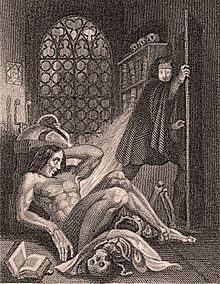
Horror is a genre of speculative fiction that is intended to disturb, frighten, or scare. Horror is often divided into the sub-genres of psychological horror and supernatural horror, which are in the realm of speculative fiction. Literary historian J. A. Cuddon, in 1984, defined the horror story as "a piece of fiction in prose of variable length ... which shocks, or even frightens the reader, or perhaps induces a feeling of repulsion or loathing". Horror intends to create an eerie and frightening atmosphere for the reader. Often the central menace of a work of horror fiction can be interpreted as a metaphor for larger fears of a society.
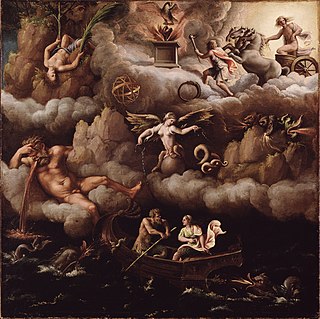
A monster is a type of fictional creature found in horror, fantasy, science fiction, folklore, mythology and religion. Monsters are very often depicted as dangerous and aggressive, with a strange or grotesque appearance that causes terror and fear, often in humans. Monsters usually resemble bizarre, deformed, otherworldly and/or mutated animals or entirely unique creatures of varying sizes, but may also take a human form, such as mutants, ghosts, spirits, zombies, or cannibals, among other things. They may or may not have supernatural powers, but are usually capable of killing or causing some form of destruction, threatening the social or moral order of the human world in the process.
Hammer Film Productions Ltd. is a British film production company based in London. Founded in 1934, the company is best known for a series of Gothic horror and fantasy films made from the mid-1950s until the 1970s. Many of these involve classic horror characters such as Baron Victor Frankenstein, Count Dracula, and the Mummy, which Hammer reintroduced to audiences by filming them in vivid colour for the first time. Hammer also produced science fiction, thrillers, film noir and comedies, as well as, in later years, television series.

Dr. Henry Jekyll and his alter ego, Mr. Edward Hyde, is the central character of Robert Louis Stevenson's 1886 novella Strange Case of Dr Jekyll and Mr Hyde. In the story, he is a good friend of main protagonist Gabriel John Utterson.
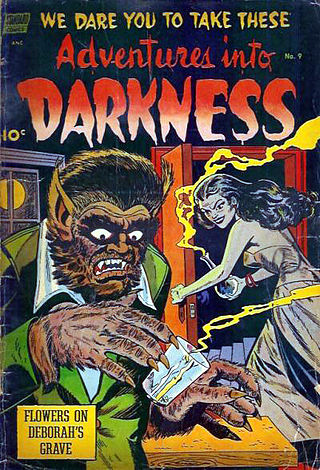
Werewolf fiction denotes the portrayal of werewolves and other shapeshifting therianthropes, in the media of literature, drama, film, games and music. Werewolf literature includes folklore, legend, saga, fairy tales, Gothic and horror fiction, fantasy fiction and poetry. Such stories may be supernatural, symbolic or allegorical. A classic cinematic example of the theme is The Wolf Man (1941) which in later films joins with the Frankenstein Monster and Count Dracula as one of the three famous icons of modern day horror. However, werewolf fiction is an exceptionally diverse genre, with ancient folkloric roots and manifold modern re-interpretations.
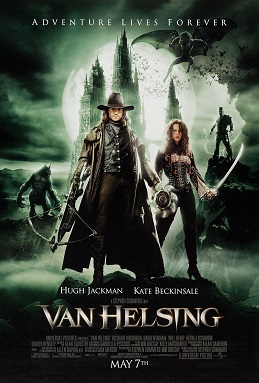
Van Helsing is a 2004 action horror film written and directed by Stephen Sommers. It stars Hugh Jackman as monster hunter Van Helsing and Kate Beckinsale as Anna Valerious. Van Helsing is both an homage and tribute to the Universal Horror Monster films from the 1930s and 1940s, of which Sommers is a fan.

Monster Force is a 13-episode animated television series created in April 9, 1994 by Universal Cartoon Studios and Canadian studio Lacewood Productions. The story is set in approximately 2020 and centers on a group of teenagers who, with help of high tech weaponry, fight off against classic Universal Monsters and spiritual beings threatening humanity. Some of the crew have personal vendettas, while others fight for mankind out of a sense of altruism. The series aired in syndication alongside another Universal animated series, Exosquad. Universal Studios Home Entertainment released the first seven episodes to DVD on September 15, 2009.

The Gothic double is a literary motif which refers to the divided personality of a character. Closely linked to the Doppelgänger, which first appeared in the 1796 novel Siebenkäs by Johann Paul Richter, the double figure emerged in Gothic literature in the late 18th century due to a resurgence of interest in mythology and folklore which explored notions of duality, such as the fetch in Irish folklore which is a double figure of a family member, often signifying an impending death.

Mary Shelley's 1818 novel Frankenstein; or, The Modern Prometheus, and the famous character of Frankenstein's monster, have influenced popular culture for at least a century. The work has inspired numerous films, television programs, video games and derivative works. The character of the Monster remains one of the most recognized icons in horror fiction.
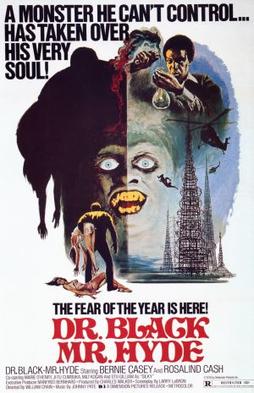
Dr. Black, Mr. Hyde is a 1976 blaxploitation horror film loosely inspired by the 1886 novella Strange Case of Dr. Jekyll and Mr. Hyde by Robert Louis Stevenson. The film stars Bernie Casey and Rosalind Cash, and was directed by William Crain. Along with Crain, and it was written by Larry LeBron and Lawrence Woolner with cinematography by Tak Fujimoto. It was filmed primarily in Los Angeles, at locations such as the Watts Towers.

Van Helsing is an action-adventure video game for the PlayStation 2, Xbox and Game Boy Advance, which is based on the 2004 action horror film of the same name by Stephen Sommers. Hugh Jackman and Richard Roxburgh reprise their roles from the film. The game is one of the few games on Playstation 2 that can run in 480p.

Mad Monster Party? is a 1967 stop-motion animated musical comedy film produced by Rankin/Bass Productions for Embassy Pictures. The film stars the voices of Boris Karloff, Allen Swift, Gale Garnett, and Phyllis Diller. It tells the story of a mad scientist who achieves the secret of total destruction as he summons all the monsters to his island home to show it off while planning to retire as the head of the "Worldwide Organization of Monsters".

Strange Case of Dr Jekyll and Mr Hyde is an 1886 novella written by the Scottish author Robert Louis Stevenson. It is about a London lawyer, Gabriel John Utterson, who investigates strange occurrences between his old friend, Dr. Henry Jekyll and the misanthropic Mr. Hyde. In a twist ending, it is revealed that Jekyll and Hyde were the same person, and that Jekyll had regularly transformed himself into Hyde by drinking a serum.

Urban Gothic is a sub-genre of Gothic fiction, film horror, and television dealing with industrial and post-industrial urban society. It was pioneered in the mid-19th century in Britain, Ireland, and the United States, before being developed in British novels such as Robert Louis Stevenson's Strange Case of Dr Jekyll and Mr Hyde (1886) and Irish novels such as Oscar Wilde's The Picture of Dorian Gray (1890) and Bram Stoker's Dracula (1897). In the twentieth century, urban Gothic influenced the creation of the sub-genres of Southern Gothic and suburban Gothic. From the 1980s, interest in the urban Gothic was revived with books like Anne Rice's Vampire Chronicles and a number of graphic novels that drew on dark city landscapes, leading to adaptations in film including Batman (1989), The Crow (1994) and From Hell (2001), as well as influencing films like Seven (1995).
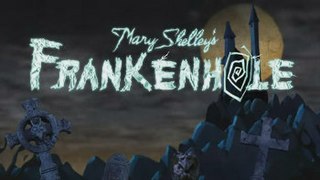
Mary Shelley's Frankenhole is an American adult stop motion-animated television series created by Dino Stamatopoulos for Cartoon Network's late night programming block Adult Swim. The series premiered on June 27, 2010 and ended on March 25, 2012, with a total of 20 episodes, over the course of 2 seasons.

Mad Mad Mad Monsters is a 1972 traditional animated Halloween-themed comedy short film produced by Rankin/Bass Productions in the United States and animated overseas by Mushi Production in Japan. The special aired on September 23, 1972 as an episode of The ABC Saturday Superstar Movie. It is "related" to the 1967 stop motion animated film Mad Monster Party?

Mel Foster and the Demon Butler is a 2015 gothic children's novel by Julia Golding. Golding also writes under the pen names of Joss Stirling and Eve Edwards. Mel Foster and the Demon Butler has been published by Egmont Publishing in August 2015. The publishing deal was announced in January 2015. The novel is the first book in an adventure series. The next book, Mel Foster and the Time Machine, was published in April 2016.

A Gothic film is a film that is based on Gothic fiction or common elements from such fictional works. Since various definite film genres—including science fiction, film noir, thriller, and comedy—have used Gothic elements, the Gothic film is challenging to define clearly as a genre. Gothic elements have especially infused the horror film genre, contributing supernatural and nightmarish elements.

The Strange Case of the Alchemist's Daughter is a 2017 novel by Theodora Goss. It is her debut novel, though she is an author of many short works. Strange Case is the first installment of The Extraordinary Adventures of the Athena Club series, and is followed by European Travel for the Monstrous Gentlewoman. The story follows Mary Jekyll, daughter of the literary character Dr. Jekyll, as she meets and connects with the fictional daughters of major literary characters, and works with and faces various famous 19th century literary personae, including Sherlock Holmes and Dr. Watson, Frankenstein's monster, and others to solve the mystery of a series of killings in London, as well as the mystery of her own family story. Drawing on classic gothic and horror creations of the 19th century, such as The Strange Case of Dr. Jekyll & Mr. Hyde, Frankenstein, Rappaccini's Daughter, The Island of Doctor Moreau, Dracula and the Sherlock Holmes stories, Goss reimagines the works of such literary greats as Mary Shelley, Robert Louis Stevenson, H. G. Wells, Bram Stoker and Nathaniel Hawthorne from a feminist perspective, as well as the historical record of the Jack the Ripper murders. At the center of the narrative is the connection and various experiences of the women who form the Athena Club, the oppressions they experience, and how they empower each other to accomplish great things.

The history of horror films was described by author Siegbert Solomon Prawer as difficult to read as a linear historical path, with the genre changing throughout the decades, based on the state of cinema, audience tastes and contemporary world events.
